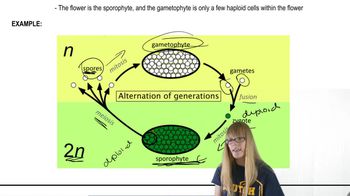Which of the following is true regarding reverse transcriptase?
Table of contents
- 1. Introduction to Genetics51m
- 2. Mendel's Laws of Inheritance3h 37m
- 3. Extensions to Mendelian Inheritance2h 41m
- 4. Genetic Mapping and Linkage2h 28m
- 5. Genetics of Bacteria and Viruses1h 21m
- 6. Chromosomal Variation1h 48m
- 7. DNA and Chromosome Structure56m
- 8. DNA Replication1h 10m
- 9. Mitosis and Meiosis1h 34m
- 10. Transcription1h 0m
- 11. Translation58m
- 12. Gene Regulation in Prokaryotes1h 19m
- 13. Gene Regulation in Eukaryotes44m
- 14. Genetic Control of Development44m
- 15. Genomes and Genomics1h 50m
- 16. Transposable Elements47m
- 17. Mutation, Repair, and Recombination1h 6m
- 18. Molecular Genetic Tools19m
- 19. Cancer Genetics29m
- 20. Quantitative Genetics1h 26m
- 21. Population Genetics50m
- 22. Evolutionary Genetics29m
16. Transposable Elements
Transposable Elements in Eukaryotes
Problem 9
Textbook Question
The human genome contains a large number of pseudogenes. How would you distinguish whether a particular sequence encodes a gene or a pseudogene? How do pseudogenes arise?
 Verified step by step guidance
Verified step by step guidance1
Understand the definition of pseudogenes: Pseudogenes are non-functional sequences in the genome that resemble functional genes but have lost their ability to encode proteins due to mutations or other changes.
To distinguish between a gene and a pseudogene, analyze the sequence for key features of functional genes, such as the presence of an intact open reading frame (ORF), regulatory elements (e.g., promoters), and splice sites. Pseudogenes often lack these features or have mutations disrupting them.
Perform comparative genomic analysis: Compare the sequence in question to known functional genes. Pseudogenes often show high sequence similarity to functional genes but may contain stop codons, frameshift mutations, or deletions that prevent proper protein synthesis.
Investigate transcriptional activity: Use techniques like RT-PCR or RNA sequencing to determine if the sequence is transcribed into RNA. Functional genes are typically transcribed, while pseudogenes may not be actively transcribed or produce non-functional RNA.
Understand how pseudogenes arise: Pseudogenes can originate through processes such as gene duplication followed by mutation (resulting in non-functional copies) or retrotransposition, where reverse-transcribed RNA is inserted back into the genome without proper regulatory elements.
 Verified video answer for a similar problem:
Verified video answer for a similar problem:This video solution was recommended by our tutors as helpful for the problem above
Video duration:
1mPlay a video:
Was this helpful?
Key Concepts
Here are the essential concepts you must grasp in order to answer the question correctly.
Gene vs. Pseudogene
A gene is a sequence of DNA that encodes a functional product, typically a protein, while a pseudogene is a non-functional sequence that resembles a gene but has lost its ability to be expressed. Pseudogenes can arise from mutations that disrupt the coding sequence or regulatory elements necessary for gene expression, rendering them inactive.
Recommended video:
Guided course

Mapping Genes
Functional Analysis
To distinguish between a gene and a pseudogene, functional analysis is crucial. This involves examining the sequence for features such as open reading frames (ORFs), promoter regions, and conservation across species. If a sequence lacks these features or shows signs of degradation, it is likely a pseudogene.
Recommended video:
Guided course

Functional Genomics
Mechanisms of Pseudogene Formation
Pseudogenes can arise through several mechanisms, including gene duplication, retrotransposition, and point mutations. Gene duplication creates a copy of a gene that may accumulate mutations over time, while retrotransposition involves the reverse transcription of mRNA into DNA, which can insert non-functional copies into the genome.
Recommended video:
Guided course

Formation of Plant Gametes

 3:21m
3:21mWatch next
Master Eukaryotic Transposable Elements with a bite sized video explanation from Kylia
Start learningRelated Videos
Related Practice
Multiple Choice
419
views
1
rank
